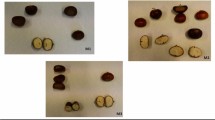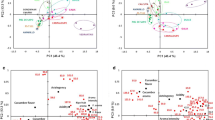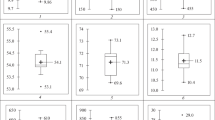Abstract
Seven typologies of melon belonging to Inodorus and Cantalupensis horticultural groups have been assayed in relation to their sensory and physical–chemical characteristics. Sensory analysis has been performed by means of a descriptive profiling based on objective scales and a trained panel. Multivariate analysis was applied to the individual results associated with the attributes of color, firmness, juiciness, sweetness, acidity, fibrosity and seven different aromas. Accuracy of the panel members and validity of the method were confirmed by the correlation between sensory scores and physical–chemical rates of firmness, juiciness, º Brix and pH. Relationships between sensory parameters and consumer preferences were also identified, resulting in concrete quality marks: high sweetness and juiciness, yellow flesh, moderate acidity and aromas of cucumber, watermelon, pineapple and peach. Additionally, the consumer’s internal map of preferences was developed in order to guide future genetic improvement programs.



Similar content being viewed by others
References
Bartoszewski G, Niedziela A, Szwacka M, Niemirowics-Szczytt K (2003) Modification of tomato taste in transgenic plants carrying a thaumatin gene from Thaumatococcus daniellii Benth. Plant Breed 122:347–351
Hampson CR, Quamme HA, Hall JW, MacDonald RA, King MC, Cliff MA (2000) Sensory evaluation as a selection tool in apple breeding. Euphytica 111:79–90
Causse M, Lecompte L, Baffert N, Duffe P, Hospital F (2001) Market-assisted selection for the transfer of QTLs controlling fruit quality traits into tomato elite lines. In Dore C, Dosba F, Baril C (eds) Acta horticulturae, vol 546, pp 557–564
Wismer WV, Harker FR, Gunson FA, Rossiter KL, Lau K, Seal AG, Lowe RG, Beatson R (2005) Identifying flavour targets for fruit breeding: a kiwifruit example. Euphytica 141:93–104
Harker FR, Gunson FA, Jaeger FR (2003) The case of fruit quality: and interpretative review of consumer attitudes and preferences for apples. Postharvest Biol Technol 28:333–347
Jaeger SR, Harker FR (2005) Consumer evaluation of novel kiwifruit: willingness-to-pay. J Sci Food Agric 85:2519–2526
Llácer G, Díez MJ, Carrillo JM, Badenes ML (2006) Mejora genética de la calidad en plantas. Sociedad Española de Ciencias Hortícolas. Sociedad Española de Genética, UPV
Moskowitz HR (1993) Sensory analysis procedures and viewpoints: intellectual history, current debates future outlooks. J Sens Stud 8:241–256
Meilgaard M, Civille GV, Carr BT (1999) Sensory evaluation techniques, 3rd edn. CRC Press, Florida
Munger HM, Robinson RW (1991) Nomenclature of Cucumis melo L. Cucurbit Genet Coop Rep 14:43–44
Lester GE, Shellie KC (1992) Postharvest sensory and physicochemical attributes of Honey Dew melon fruits. HortScience 27:1012–1014
Hoberg E, Ulrich D, Schulz H, Tuvia-Alkali S, Fallik E (2003) Sensory and quality analysis of different melon cultivars after prolonged storage. Nahrung/Food 47:320–324
Saftner R, Abbott JA, Lester G, Vinyard B (2006) Sensory and analytical comparison of orange-fleshed honeydew to cantaloupe and green-fleshed honeydew for fresh-cut chunks. Postharvest Biol Technol 42:150–160
Kourkoutas D, Elmore JS, Mottram DS (2005) Comparison of the volatile compositions and flavor properties of cantaloupe, galia and honey dew muskmelons. Food Chem 97:95–102
Lester GE (2006) Consumer preference quality attributes of melon fruits. In: ISHS (ed) Acta Hort 712
Escribano S, Lázaro A (2009) Agromorphological diversity of Spanish traditional melons (Cucumis melo L.) of the Madrid provenance. Genet Resour Crop Evol 56:481–497
Code of European Community Regulations (ed) (2001) Diario Oficial de las Comunidades Europeas. No 1615/2001. Brussels, Belgium
Aenor (ed) (1997) Recopilación de normas UNE, 1. Alimentación. Análisis sensorial. AENOR. N.A. 71.970
Palma-Harris C, McFeeters RF, Fleming HP (2001) Solid-phase microextraction (SPME) technique for measurement of generation of fresh cucumber flavor compounds. J Agric Food Chem 49:4203–4207
Jordan MJ, Margaria CA, Shaw PE, Goodner KL (2002) Aroma active components in aqueous kiwi fruit essence and kiwi fruit puree by GC-MS and multidimensional GC/GC-O. J Agric Food Chem 50:5386–5390
Beaulieu JC, Lea JM (2006) Characterization and semiquantitative analysis of volatiles in seedless watermelon varieties using solid-phase microextraction. J Agric Food Chem 54:7789–7793
Pino JA, Mesa J (2006) Contribution of volatiles compounds to mango (Mangifera indica L.) aroma. Flavour and fragrance journal 21:207–213
Aubert C, Milhet C (2007) Distribution of the volatile compounds in the different parts of a white-fleshed peach (Prunus persica L. Batsch). Food Chem 102:375–384
Lester GE (2008) Antioxidant, sugar, mineral, and Phytonutrient concentrations across edible fruit tissues of orange-fleshed Honeydew melon (Cucumis melo L.). J Agric Food Chem 56:3694–3698
Box GEP, Cox DR (1964) An analysis of transformations. J R Stat Soc Ser B 26:211–246
Hair J, Anderson R, Tatham R, Black W (1999) Análisis multivariante, 4th edn. Prentice Hall, Spain
Wyllie SG, Leach DN (1992) Sulfur-containing compounds in the aroma volatiles of melons (Cucumis melo L.). J Agric Food Chem 40:253–256
Burger Y, Sa′ar U, Paris HS, Lewinsohn E, Katzir N, Tadmor Y, Schaffer AA (2006) Genetic variability for valuable fruit quality traits in Cucumis melo. Israel J Plant Sci 54:233–242
Greenhoff K, MacFie HJH (1994) Preference map** in practice. In: MacFie HJH, Thomson DMH (eds) Measurements of food preferences. Blackie Academic Prof, London, pp 137–166
Acknowledgments
This research was supported by a Ph.D. grant from the Comunidad de Madrid, belonging to the Order 3832/2004, 28th April, and the financing from European Regional Development Fund (ERDF) & INIA (Spanish Institute for Agro Food Research) project RTA2006-00083-00-00.
Author information
Authors and Affiliations
Corresponding author
Appendix: Practical applications
Appendix: Practical applications
The sensory protocol for melon established herein has been demonstrated as being effective, efficient and useful for horticultural and seed companies. Effective, since it provides for the first time a concrete sensory profile of several melon market classes. Efficient, because it gives superior information at a low cost when compared to physical–chemical methods. Useful, as it broadens knowledge of human perception of melon sensory attributes and their relative contribution to the overall judgment of quality. This link between sensory attributes and consumer preferences makes out of this protocol a key tool to define selection criteria within breeding programs, ensuring success of enhanced products among consumers.
Rights and permissions
About this article
Cite this article
Escribano, S., Sánchez, F.J. & Lázaro, A. Establishment of a sensory characterization protocol for melon (Cucumis melo L.) and its correlation with physical–chemical attributes: indications for future genetic improvements. Eur Food Res Technol 231, 611–621 (2010). https://doi.org/10.1007/s00217-010-1313-8
Received:
Revised:
Accepted:
Published:
Issue Date:
DOI: https://doi.org/10.1007/s00217-010-1313-8




